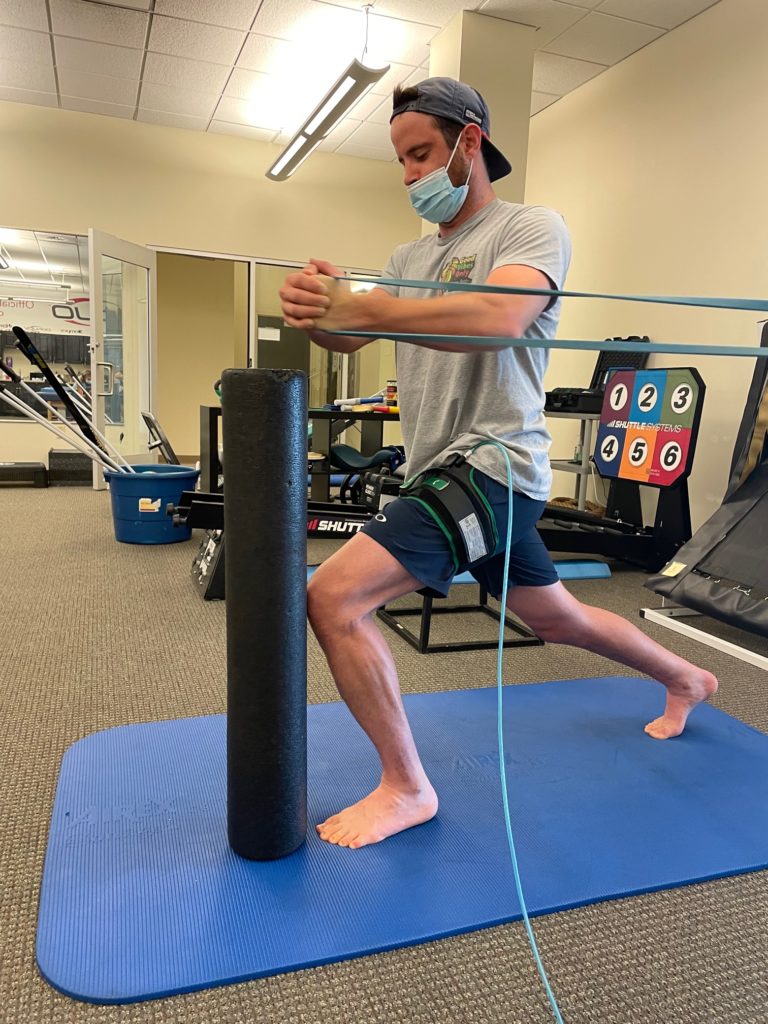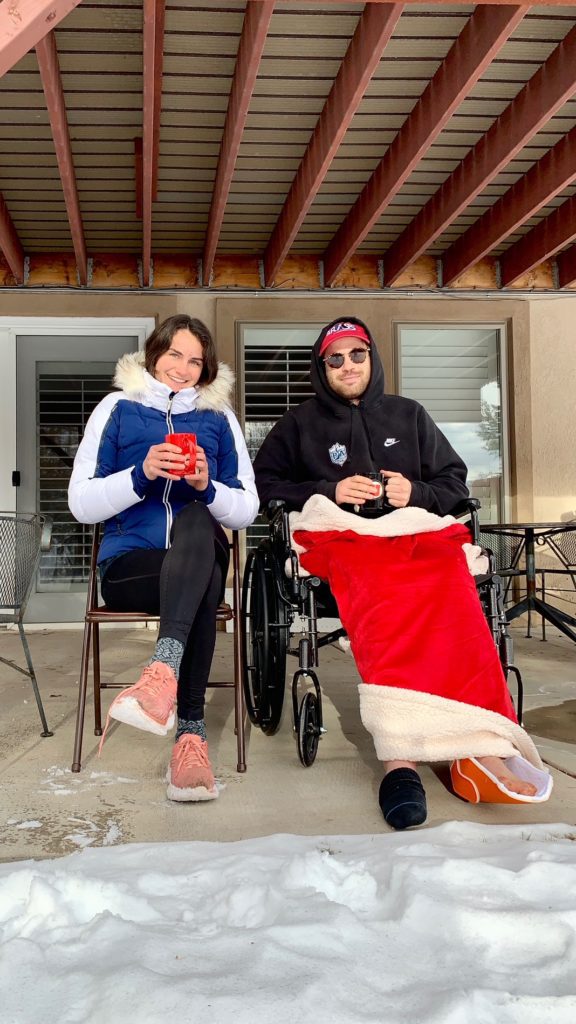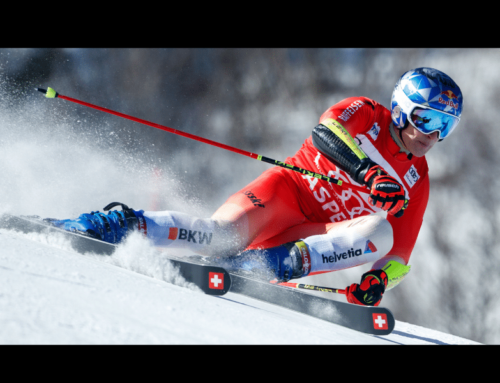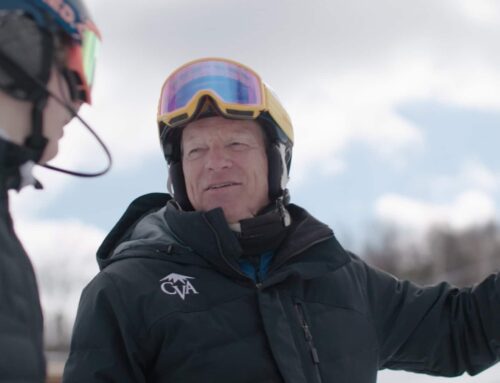Sam DuPratt’s road to recovery after two broken legs
If there’s a positive takeaway from breaking both your legs, it’s that you get to finish school when you’re 27.
That’s the attitude Sam DuPratt is harnessing nine months after his season-ending crash, and he’s accomplished just that — graduating from the University of Utah with a degree in accounting. He also racked up 14 hours of surgery, two permanent rods in each leg, and five months of non-weight-bearing restriction, which he spent mostly in a wheelchair.
After parting ways with the U.S. Ski Team to pursue a collegiate ski career in Utah, the former NorAm super G champ wanted to take another crack at the World Cup speed circuit before hanging up the long boards. His 2019-20 season was spent as a Ski Team invitee, scoring results that earned him a spot on the B team for 2020-21. He was early into his ‘return to speed’ career when a confident DuPratt pushed out of the start gate in Val Gardena, Italy, en route to what would ultimately be a crash that nearly ended his career.
DuPratt was approaching the bottom of the downhill training run on Dec. 17, 2020, when he hit a hole that kicked his skis into the gate, which he straddled. Mid-crash, he thought it was going to be a miraculous recovery. But then his left leg snapped, and then the right. In the short moments following the crash, and as shock settled in, DuPratt saw the end of his ski racing career while the helicopter approached to airlift him to a nearby hospital in Bolzano to undergo a nine-hour surgery for a broken tibia and fibula in each leg.
It was six dark days spent in the Italian hospital before a 21-hour travel day in a stretcher bed from Innsbruck, Austria, to his parents’ front door in Park City. DuPratt met with U.S. doctors, who after further evaluation, determined his left fibula — which was left un-repaired in the initial surgery — would require a second, shorter procedure.
Building back strength
The first weeks after his second surgery were challenging for DuPratt, who relied on his family to help mobilize him around the house while wheelchair-bound. Sitting up for extended periods of time would cause blood to pool into his legs, resulting in headaches and swelling. Fortunately during his time of limited mobility DuPratt was enrolled in a full online course load at the University of Utah to consume his day. As soon as he was able to get off the couch, and the swelling subsided, DuPratt added physical therapy to his daily routine, primarily working on blood flow restrictive training to freshen the blood in his lower legs and slowly build muscle back.
“I was spending pretty much all day busy, which was really good for me mentally,” said DuPratt. “I was doing battle ropes in a wheelchair, bench pressing in a wheelchair, it was like a new way of working out. Then I would hustle home for school.”
DuPratt relied on his wheelchair for nearly four months after the crash before moving to a six-week crutch period, and eventually progressing to what he describes as a ‘waddle’ at the five-month mark.
Walking brought extreme pain, so much that DuPratt would rotate his feet outward to avoid pushing through his toe box. He slowly progressed back to the squat rack alongside fellow teammates recovering at the Center of Excellence. Yet despite having no movement restrictions, DuPratt had agonizing pain in his right leg.
“I thought it was just pain from the plate in there, the plate in my right leg was massive and had so many screws. I thought it was just muscle rubbing on plates,” said DuPratt. “I mean you broke both your legs, it makes sense you are in some pain.”
Running, jumping, even calf raises caused swelling in his right leg. DuPratt recalls feeling great as he was dead-lifting heavy weight, but as soon as he put the weight down, he would experience an intense throbbing.
“We worked around it, but I just thought it was part of the process,” said DuPratt. “Turns out my leg just stopped healing on me. It all makes sense now.”
X-rays had already been scheduled before his final surgery to remove a majority of the hardware in both legs. That’s when doctors found the nonunion in his right leg. Essentially, his right leg was no longer healing due to the large amount of metal placed in his first surgery. His surgeons stuck to their plan to remove the hardware, and would add a new rod to stabilize and heal the right leg.
Surgery No. 3
DuPratt admits his prep was flawed going into his final surgery. He was convinced the surgery wouldn’t be painful and he was excited to take home every piece of metal they would be removing from his legs.

“It kicked my ass,” said DuPratt. “I fully atrophied again. I was full non-weight bearing for another two weeks.”
During the surgery, his surgeon removed a fibula plate, fibula rod and tibia plate out of his left leg, and removed the large tibia and fibula plate in his right leg. But the nonunion meant DuPratt gained a new rod in his right leg with four new bolts, earning him two lifelong rods in each lower leg.
“Both rods have to stay in for life, unfortunately,” explained DuPratt. “There were four major breaks in my left leg. When the bone heals, it squeezes around the rod and basically if they go to hammer that rod out, the leg essentially breaks again. It’s kinda a bummer. There are not many people out there who ski with rods in, but it’s doable.”
DuPratt’s doctor joked, with a younger and stronger surgeon, they might be able to get the rod out, but the odds of his legs breaking again are too high. The addition of the rod in his right leg had accompanying screws, which were strategically placed flush to the bone. The odds of DuPratt skiing this winter increased, but the odds also increased for the bone to grow over the screws and prevent the right rod from being removed in the future.

“My foot was more of a fish fin rather than a foot,” joked DuPratt describing his right leg before the third surgery. “My PTs at the U.S. Ski Team measured it a couple times rotated out at 40 degrees — my left foot was about 18 degrees rotated outward. When my right leg broke I was spun around backwards, so the joke was they didn’t rotate it back all the way it was supposed to be in surgery. So I was all pissed off because they bolted my foot on wrong, but after this (recent) surgery my feet are on straight and I’m in a lot less pain.”
DuPratt’s third surgery in early August already has him feeling like he’s progressed faster in a month than he did rehabbing his right leg in the eight months prior. The addition of the rod did not re-break any bones or cause any new scar tissue, and two-weeks non-weight bearing helped with the immense pain, essentially from a severe bone bruise. Two weeks back on both feet and DuPratt sees the green light ahead.
Daydreams and nightmares
Reflecting back to the moment he came to a sliding stop into the nets in Val Gardena, the initial belief was he would never return to ski racing. His Italian doctor confirmed his fears, relaying to DuPratt he would not return to competition. But when he landed in the U.S., his stateside doctor stated he would ultimately recover, and what’s more, he would be just fine. So began his daydream of returning to ski racing — as did the nightmares.
DuPratt’s nervous mental state led him to form a relationship with USST sports psychologist Ricki Walker. Their first sessions together were spent on a weekly cadence guiding DuPratt through the trauma of his crash and ultimately getting him to watch his crash months later.
“It helped a lot,” said DuPratt, reflecting on the video of his crash. “It kinda made it worse but also helped. It’s better to address it than to hide from it. I can’t pretend like it didn’t happen and hide from it. Then, as soon as I hit a bump on a GS course I would probably freak out, so hopefully addressing that makes it easier to overcome when the time comes.”
DuPratt will ski — and race — again
Looking ahead, DuPratt is somewhat relieved to know the chances of him pushing out of a start gate this season are slim. If asked to put on ski boots today he might chuckle, yet in November his humorous joke will be reality for his first return-to-snow camp at Copper Mountain. Beyond November, his timing is unknown. His training program will be dictated by pain, but he hopes to join his teammates in Europe at some point this winter.
Structurally, DuPratt could race tomorrow, but he foresees pain sliding around in boots, and recognizes that racing while in pain is a dangerous activity. Throughout his entire recovery DuPratt has applauded his U.S. doctor who has accurately predicted every healing pattern. The latest forecast is a return to competition in the spring of 2022, at the earliest.
No longer sidelined in a wheelchair, DuPratt anticipates remaining local in Park City to train and plans to add a job to the mix to support himself financially. While he recognizes many of his current employment options involve time spent in ski boots, DuPratt hesitates to spend any additional time on snow that could hamper his goal of getting back in the race course.
“I need to figure out what I’m going to do, I need to make some money,” shared DuPratt. “A lot of the jobs I’m qualified for involve time in ski boots and I don’t want to take away from my comeback. I don’t know, maybe I’ll bartend.”
Reflecting on his previous nine months of recovery, DuPratt shares his respect and admiration for fellow teammates and athletes who have come back from serious injuries. Throughout his journey he’s learned just how every injury is different — even within his own journey experiencing two completely different injuries in each leg with the same broken bones.
“l’ll just say how much respect I have for all the athletes who have come back from serious injuries,” said DuPratt. “You watch and see how hard it is, but you don’t really understand the mental battle of it all. I never realized how much strength, physically and mentality, it took, so hats off to all the people who have been there, have gotten through it, and come back better.”
















